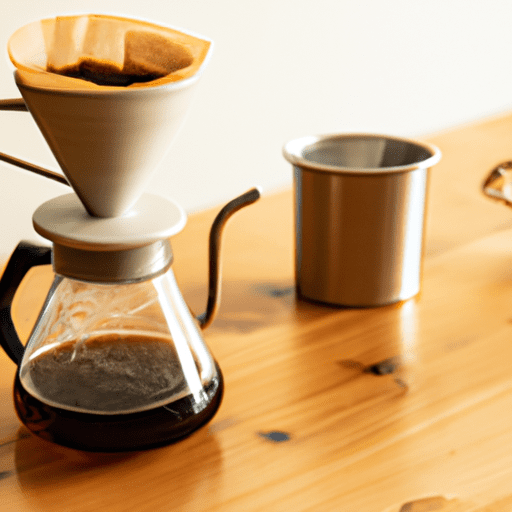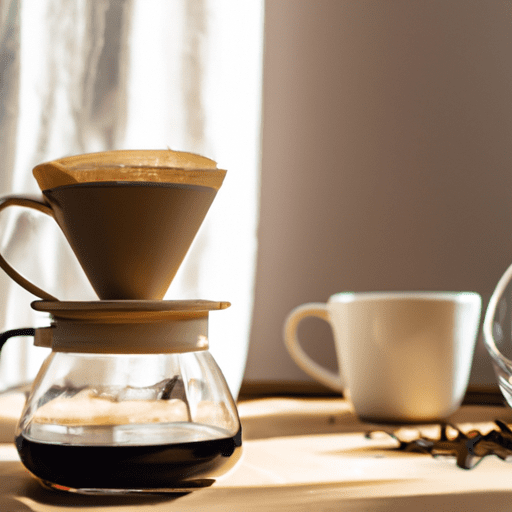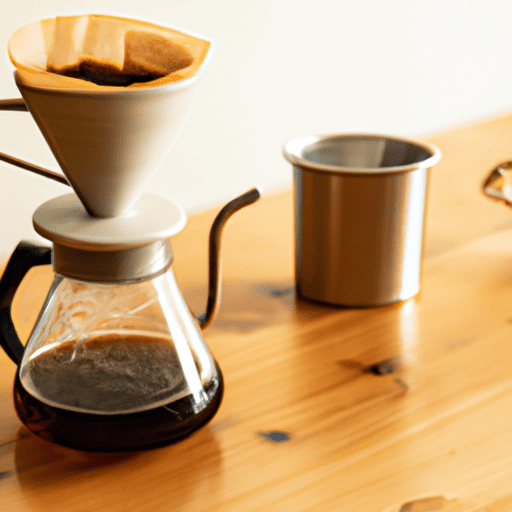Right off the bat, let’s talk about an age-old secret closely guarded by coffee connoisseurs: the reason why pour-over coffee has a less bitter taste! This article will take you down the fascinating path of discovering why this beloved morning ritual results in a smoother, friendlier cup of joe. You’ll explore how the brewing process, water temperature, coffee grind size, and choice of filter create this magic and eventually, you’ll find yourself engrossed in the seductive world of pour-over coffee. Let’s perk up and brew a delicious journey together!

Understanding Pour Over Coffee
What is pour over coffee?
pour over coffee is one of the simplest and most traditional ways to brew coffee. At its most basic, pour over coffee method involves pouring hot water over ground coffee beans that are placed in a filter. The water then steeps in the coffee, extracting its oils and essences, before dripping down into a carafe or cup. This slow and deliberate brewing method results in a cup of coffee that is clear, clean, and full of nuanced flavors.
How is pour over coffee different from other brewing methods?
Unlike other brewing methods like the espresso, French press, or automatic coffee maker, pour over coffee gives you complete control over every aspect of the brewing process – from the water temperature to the speed and direction of your pour. This method relies mostly on gravity, rather than pressure or immersion, which leads to a unique, high-quality cup of coffee. It allows you to highlight the distinct characteristics of different beans and brings out the subtle flavors that might be missed in other brewing methods.
Why is pour over coffee gaining popularity?
Pour over coffee is gaining popularity for a number of reasons. For one, it demands attention and awareness, turning the act of coffee brewing from a daily routine into a mindful ritual. Additionally, it allows coffee enthusiasts to experiment with their brewing parameters, leading to a personalized cup each time. Lastly, the pour over method results in a clean and aromatic coffee with less bitterness compared to other brewing methods.
Chemical Factors in Coffee Bitterness
What causes the bitterness in coffee?
The bitterness in coffee is mainly attributed to caffeine and a group of chemical compounds known as chlorogenic acid lactones. Roasting breaks down chlorogenic acids into these bitter-tasting lactones. Another notable compound contributing to bitterness is quinic acid, which increases when the coffee is brewed for longer periods.
How do different brewing methods affect bitterness?
Different brewing methods affect the bitterness and taste of coffee by controlling the extraction process. In general, the longer the coffee grounds are in contact with hot water, the more bitter compounds are extracted. So, methods like espresso, which use pressure to extract flavors quickly, tend to produce coffee with less bitterness compared to methods like French press that immerse coffee grounds in hot water for longer periods.
Exploring the role of acids, oils, and compounds in bitterness
The balance of acids, oils, and other compounds determines the taste profile of the coffee. Coffee contains many types of acids, some of which contribute to its refreshing flavor, while others give an unpleasant, sour taste. Certain oils extracted during brewing contribute to the perceived bitterness. The aim of good brewing technique is to extract these various compounds in just the right balance to achieve a pleasant taste.
Pour Over Brewing Technique
Step-by-step guide to pour over brewing
- Heat the water to around 200 degrees Fahrenheit.
- Place a paper filter in your pour over cone.
- Grind your coffee beans to a medium or medium-coarse consistency.
- Put the ground coffee into the filter.
- Pour just enough hot water to wet the coffee grounds and let them “bloom” for about 30 seconds.
- Slowly pour the rest of the water over the grounds in a spiral motion, starting from the center.
The role of water temperature in reducing bitterness
The water temperature during brewing significantly affects the taste of the coffee. Too hot, and it could over-extract your coffee, leading to bitterness. Too cool, and it may under-extract, resulting in a weak and underwhelming brew. Experts often recommend a temperature between 195 to 205 degrees Fahrenheit for optimal extraction.
The importance of proper grind size for a smoother taste
The grind size plays a critical role in the brewing process. A finer grind size increases the surface area exposed to water, leading to more extraction, while a coarser grind reduces the extraction. In pour over brewing, a medium to medium-coarse grind is often preferred. This allows water to pass through at a steady rate and encourages a balanced extraction for a smoother, less bitter taste.

Controlled Extraction Process
How pour over coffee allows control over extraction
Pour over method offers unrivaled control over the extraction process which ultimately affects the coffee’s flavor. By adjusting the grind size, water temperature, and pour rate, you are able to control the amount and type of compounds extracted from the coffee. This allows you to manipulate the strength and taste of your coffee to your precise preference.
The impact of extraction time on bitterness
The extraction time or contact time of water and coffee significantly affects the flavor profile. A longer extraction time allows more bitter compounds to be pulled from the coffee, resulting in a bitter brew. Whereas, a shorter extraction time may lead to a weak and under-extracted coffee. With pour over brewing, the extraction time can be fine-tuned by adjusting the grind size and pour rate, enabling an ideal balance of flavors.
Balancing flavors through pour over technique
The pour over technique allows you to create a balance of flavors by effectively managing the extraction. This balance is achieved by concurrently extracting the right amount of acids, sugars, and bitter compounds. The result is a harmonious cup, nuanced and distinct, where no flavor overpowers the other.
Filtering Out Bitterness
The role of paper filters in pour over brewing
Paper filters play a crucial role in pour over brewing. They allow water to pass through the coffee grounds while trapping micro-fine particles and oils. This results in the production of a bright and clear coffee cup, devoid of sediment and bitterness that can be found in other brew methods.
How paper filters trap oils and particles
Paper filters are dense enough to trap oils and tiny particles that would otherwise end up in your cup. The oils in the coffee bean can contribute to bitter flavors, especially when the coffee cools. Therefore, by trapping these oils, paper filters can help produce a less bitter cup of coffee.
Comparing different filter materials and their impact on bitterness
Besides paper, coffee filters can also be made of metal or cloth. While each has its own benefits and drawbacks, paper filters are particularly effective at removing oils and fine particles which can lead to bitterness. Metal filters, on the other hand, allow more oils and particles to pass through, giving a more robust but potentially bitter brew. Cloth filters fall somewhere in between, removing some oils but allowing more particles through than paper filters.
Enhancing Coffee Clarity
Why pour over brewing leads to a clearer, less bitter cup
Pour over brewing, by virtue of its technique and use of paper filters, leads to a clearer and less bitter coffee. The paper filter prevents the fines, or tiny coffee particles, and oils from making their way into the final brew. This results in a clean, bright, and clear coffee with reduced bitterness and highlighted flavors.
Understanding the effect of coffee sediment on taste
Coffee sediment, resulting from fine particles making their way into your cup, can infuse your coffee with a gritty texture and muddy taste. It may also carry along certain bitter compounds from the beans. The pour over method, with the use of paper filters, effectively reduce the sediment in the final brew, leading to a cleaner and smoother taste.
Improving taste through reduction of sediment in pour over method
The pour over method is particularly effective at reducing sediment, thereby improving the taste of coffee. By employing a paper filter and controlling the pour rate, you can significantly reduce the amount of sediment in your brew. This not only makes your coffee clearer and cleaner but also elevates its taste by mitigating the bitter elements.
Water-to-Coffee Ratio
The ideal ratio for pour over coffee
When it comes to brewing pour over coffee, the water-to-coffee ratio is key to achieving an ideal balance of flavors. While the perfect ratio can vary depending upon personal taste, a commonly suggested starting point is a 1:16 or 1:17 ratio – that is one part of coffee to 16 or 17 parts of water. For instance, if you’re using 25 grams of coffee, you would aim for around 400 to 425 grams of water.
How a balanced ratio contributes to reduced bitterness
A balanced water-to-coffee ratio contributes to reduced bitterness by controlling the extraction process. If too much water is used in relation to coffee, it can over-extract the coffee, leading to a bitter taste. Conversely, if too little water is used, it may under-extract, resulting in a weak and possibly sour flavor.
Experimenting with different ratios for personal preference
While guidelines can provide a good starting point, the finer aspects of coffee brewing come down to personal taste. Don’t be afraid to experiment with different ratios until you find the one that suits your palate. You may prefer a stronger brew with a 1:15 ratio, or a lighter one with a 1:18 ratio. The beauty of pour over coffee is that it allows for such customization.
The Role of Pouring Technique
How pour speed affects bitterness
The speed at which you pour water over the coffee grounds can greatly impact the extraction process, and subsequently, the taste. Pouring too slowly may over-extract the coffee and lead to more bitter flavors being drawn out. Conversely, pouring too quickly can under-extract the coffee, resulting in weak, underdeveloped flavors. The goal is to pour at a steady and controlled rate to achieve a balanced extraction.
Mastering the art of controlled pouring
Pour over coffee is as much about the process as it is about the end result. mastering the art of controlled pouring can greatly improve the quality of your brew. Invest in a good pour over kettle that gives you control and precision over your pour. Remember, a slow, steady spiral from the center outwards is often recommended.
Pouring techniques for different coffee flavors
Different pouring techniques can bring out unique flavors in the coffee. A gentle, slow pour can highlight the delicate, complex flavors in your coffee. On the other hand, a faster pour may lead to a more robust flavor. Experiment with different pour speeds, patterns and intervals to discover new flavor profiles.
Freshness and Bitterness
The importance of using freshly roasted beans
Freshly roasted beans play an important role in making a tasty cup of coffee. Older coffee beans can lose their flavor over time and may increase bitterness. By using freshly roasted beans, you ensure that you’re getting the most delicious and aromatic cup of joe, with less bitterness.
How freshness contributes to a less bitter taste
The freshness of your beans can contribute to a less bitter taste because fresher beans are more likely to contain the right balance of flavors. Old or stale beans may produce a dull, flat, and bitter brew. So if you’re looking for a smooth, aromatic cup of coffee, it’s best to invest in high-quality, freshly roasted beans.
Storing coffee properly to preserve its freshness
Since freshness plays such a key role in making great coffee, it’s important to store your coffee properly. Keep your coffee beans in a cool, dry place and in an airtight container to prevent oxidation. Avoid storing your beans in the freezer, as the moisture can harm the beans and their flavor.
Flavor Profiles in Pour Over Coffee
Exploring the nuanced flavors in pour over coffee
One of the key reasons why coffee enthusiasts love pour over method is the ability to explore the nuanced flavors of different coffee varieties. This brewing method draws out the subtle flavor profiles that other methods often mask, allowing you to taste everything from fruity notes to floral undertones and more. This ability makes trying new beans and discovering new favorites a joy.
Differentiating taste notes in various coffee varieties
As you become more familiar with pour over coffee, you’ll start to notice different taste notes in various coffee varieties. You may be able to pick up on the sweetness or acidity of certain beans, or identify flavors like chocolate, citrus, berries, or even wine. This differentiation is made possible due to the clean and focused flavors delivered by the pour over method.
How pour over brewing enhances flavor complexity
Pour over brewing can enhance flavor complexity by allowing for a controlled and even extraction of coffee grounds. This method of brewing allows for the simple, yet profound, expression of a coffee’s unique characteristics. Whether you’re toasting a light, medium, or a dark roast, the pour over technique will ensure that you’re tasting the multitude of flavors that the coffee has to offer. Through pour over brewing, you’ll truly be able to savor the complexities within your cup of coffee.
